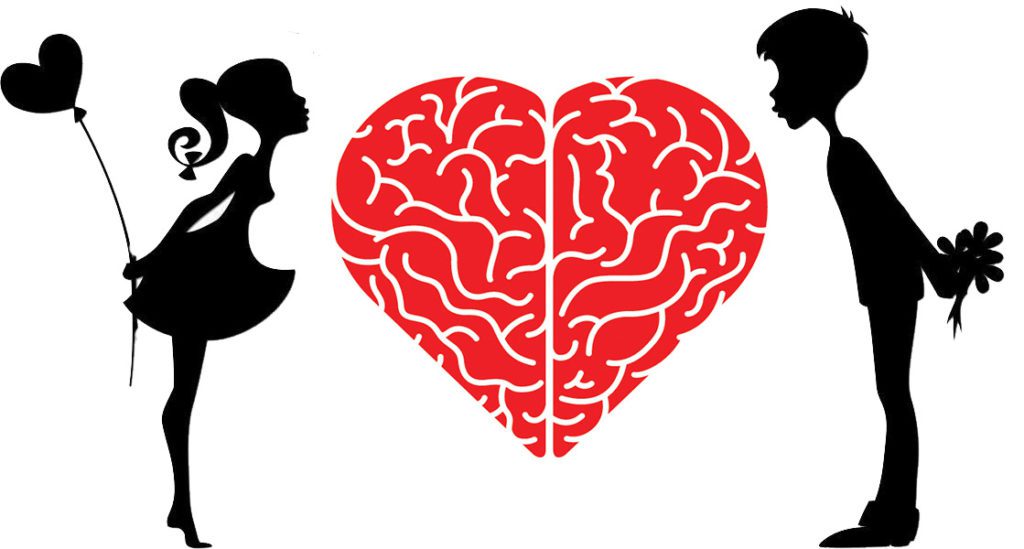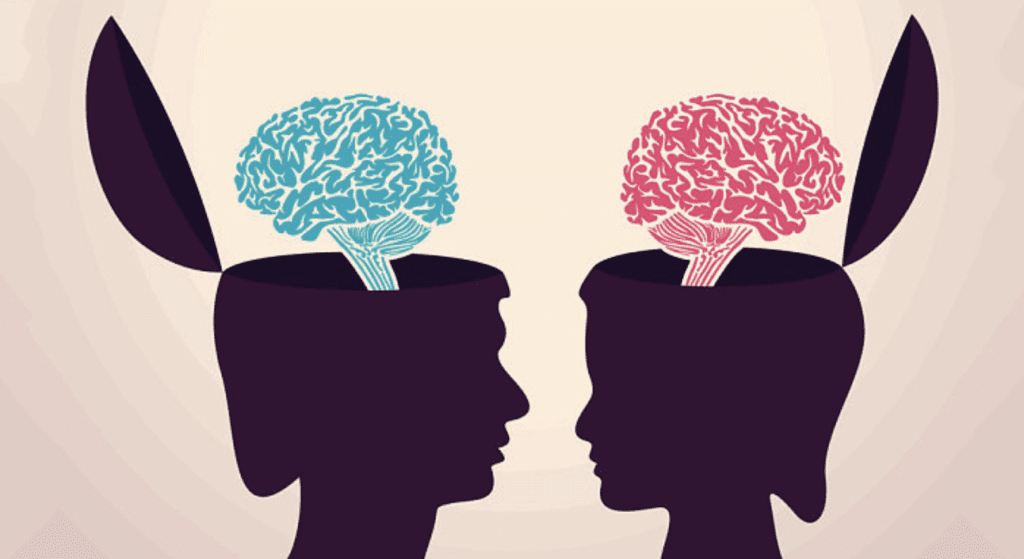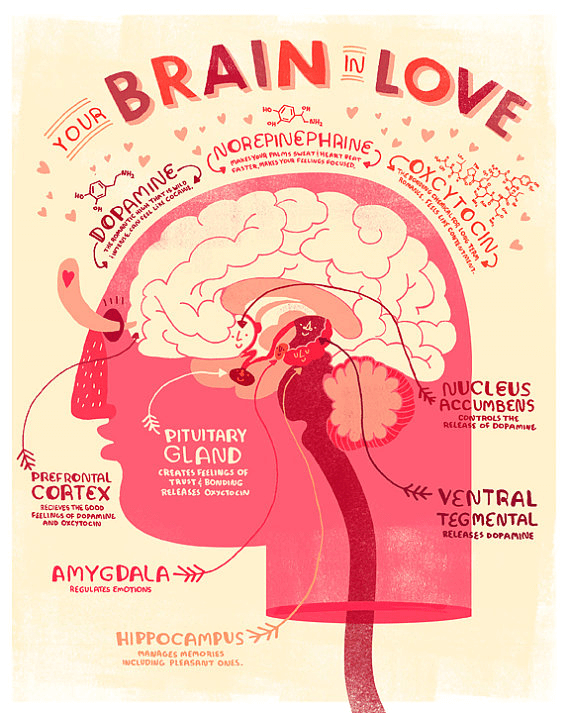Love has an intoxicating effect on us and understanding this mysterious effect from a scientific perspective may help us navigate relationships with a little more clarity. Meditation, self-awareness and good communication skills are paramount to having a successful relationship, but there are biological factors to attachment and separation that can easily override even the most level-headed person. For millennia nature has conspired to evolve complex neurological impulses that underly our desire for connection; this inner process is mirrored externally when we socially engage with the people around us. While we may never understand the inner workings of this process completely, science can shed some light on what’s going on.
Falling in love causes our body to release a flood of feel-good chemicals that trigger specific physical reactions. This internal elixir of love is responsible for making our cheeks flush, our palms sweat and our hearts race.
– Pat Mumby, Ph.D, Science Daily

Everybody Plays the Fool
Let’s start at the bottom… Love is beautiful, but it can also be addictive; causing us to do and say some crazy things. I think we all know what it feels like to “lose it”, to “melt down” or “flip out” in a moment of passion with a lover or close friend. Well, we have a special part of our brain to thank for this. It is called the amygdala, and it actually has a very important and useful function when it isn’t making us lose our cool. Hopefully we all have the ability to laugh at ourselves and each other through these outbursts; if not there are plenty of songs to console us.
How can you help it, when the music starts to play
And your ability to reason, is swept away
Oh, heaven on earth is all you see, you’re out of touch with reality
And now you cry, but when you do, next time around someone cries for youHey, everybody plays the fool, sometime
Use your heart just like a tool, listen baby
They never tell you so in school, I wanna say it again,
Everybody plays the fool

The amygdala has the ability to hijack our brain into a fight or flight mode. It comes from our pre-historic past when we were preyed upon in the wild. Our brains needed a way to bypass the higher thinking centers in those moments when we required instantaneous response to survive in life-or-death situations. So the amygdala was given the special power to override or bypass the more reasonable parts of ourself. When we are emotionally “triggered” it is the result of our amygdala perceiving some sort of danger. The ability to recognize this, pause and breathe, can do wonders in terms of helping us return to sanity during heated moments.
Romantic and maternal love are highly rewarding experiences. Both are linked to the perpetuation of the species and therefore have a closely linked biological function of crucial evolutionary importance. The newly developed ability to study the neural correlates of subjective mental states with brain imaging techniques has allowed neurobiologists to learn something about the neural bases of both romantic and maternal love. Both types of attachment activate regions specific to each, as well as overlapping regions in the brain’s reward system that coincide with areas rich in oxytocin and vasopressin receptors.
– The Neurobiology of Love, Zeki S. (2007)
Why do Fools Fall in Love?
We are manipulated (for lack of a better word) by a cocktail of neurochemicals in our brains that are associated with sex-drive, attachment, and partner preference. These motives are at the core of procreation for our species; they have a biological impetus that is older than our current lifetime, and will carry on in our offspring after we are gone. However love, sex, relationships are not just for procreating; they are also central to health, personal growth, and spirituality.
Why do birds sing so gay?
And lovers await the break of day?
Why do they fall in love?
– Frankie Lymon And The Teenagers

Neurochemical is a broad term that includes neuropeptides, and neurotransmitters. Neurotransmitters are chemicals that enable neurotransmission by transmitting signals across a chemical synapse. Neuropeptides are small protein-like molecules used by neurons to communicate with each other. Generally speaking, the major players in this chemical drama include testosterone and estrogen, which relate to sex-drive; dopamine which has to do with pleasure, addiction, and reward; oxytocin which is most commonly called the “love hormone” as it is associated with attachment and bonding – while (along with vasopressin) playing an important role in partner preference.
Couples often show the signs of surging dopamine: increased energy, less need for sleep or food, focused attention and exquisite delight in smallest details of this novel relationship.
– Dr. Helen Fisher
It’s Not Just in Your Head
According to leading theories from experts, our nervous systems are not self-contained but rather demonstrably attuned to those around us, and those with whom we are most close. This hypothesis is called limbic resonance. It is the biological explanation of the symphony of deeply shared feelings that happen when we synchronize with one another in a way that has profound implications for personality and lifelong emotional health. This phenomena is not only unique to humans, it is recognized with other mammals and across species.
Putting the Pieces Together
So now we have science to confirm just how complex and unpredictable love and relationships can be. The gift within this is the ability to begin distinguishing which needs, biological responses are being triggered. When we act like an addict regarding love we may reach for a hug to satisfy our need for attachment (get our oxytocin fix) but if our testosterone or estrogen is too amped up we may go on the prowl for sexual gratification.
Sex can lead to deeper attachment that may cause a chemical addiction to the kinds of drama that cause us to “lose it” when our amygdala senses danger (of loss, of confronting our own shadow). This perpetual cycle eventually brings us back to the basic spiritual principles and practices of letting go, forgiveness, and compassion along with a spiritual, unconditional love for self and other. Sometimes even a break-up with someone you love can be a powerful and transformative part of your personal growth.
This endless inquiry into the depths of our nature continues to illuminate the magnificence of our social lives as humans. There are some great books like Molecules of Emotion, or A General Theory of Love and websites like the Anatomy of Love which help to feed our minds with information for discussion or reflection, but nothing can replace direct experience. We all experience the highs and lows of relationships, and so much music and art we appreciate is born from the yearning, confusion, and delight of these feelings. Investigate, explore, love freely and let go. We are here to live and grow.
*If you are enjoying Culture Collective and would like to become a patron, please visit here!*


